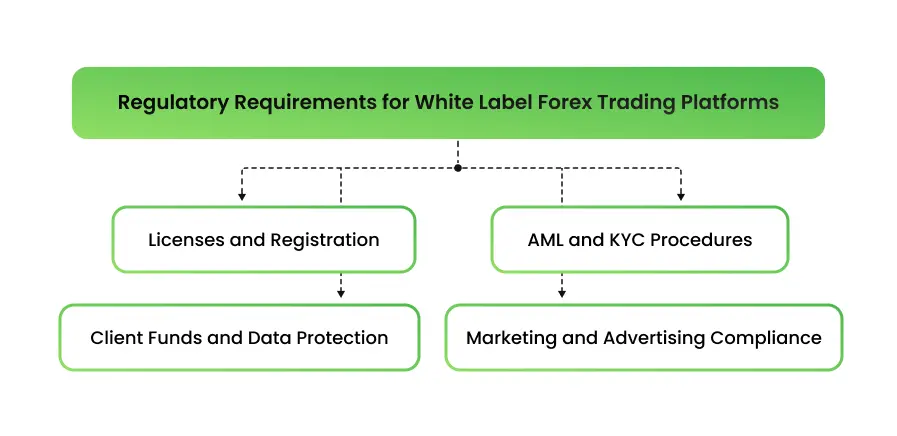Regulations for a White Label Forex Trading Platform
- Introduction
- The Forex Regulatory Landscape
- Regulatory Bodies and their Impact on Compliance
- Regulatory Requirements for White Label Forex Trading Platforms
- Managing Regulatory Compliance Across Multiple Jurisdictions
- Conclusion
- FAQs
Introduction
Forex white labeling has grown in popularity in recent years as an effective way for brokerage firms to expand their business and provide forex trading services to a broader range of clients. A white label forex trading platform allows businesses to offer branded forex trading services under the name of a brokerage firm.
While this partnership benefits both the forex brokerage and the business, all parties involved must understand the legal and regulatory requirements of this business model.
In this article, we will explore the regulatory challenges faced when launching a white label forex trading platform. We will also investigate ways to navigate these challenges to establish and manage successful white label trading solutions.
The Forex Regulatory Landscape
As the world's largest and most liquid market, with a staggering daily trading volume of over $5 billion, the Forex market's decentralized and global nature has historically made it more vulnerable to fraud and less regulated than other financial markets.
This emphasizes the need for regulation. However, regulating a market this large presents significant challenges. Addressing these challenges frequently necessitates a localized approach, similar to tackling a large task one step at a time. As a result, despite the lack of a unified global regulatory body, Forex trading is supervised by a variety of governmental and independent entities worldwide.
These regulatory bodies set and enforce standards that brokers under their jurisdiction must follow, including white label trading platforms. These standards include broker registration, licensing, periodic audits, and communication of service changes to clients, among others.
Regulatory Bodies and their Impact on Compliance
The Financial Conduct Authority (FCA) in the United Kingdom, and the Commodity Futures Trading Commission (CFTC) in the United States, are among the most well-known international regulatory bodies.
These organizations constantly monitor brokerages to prevent financial irregularities, scams, and risks that may harm traders and investors.
However, regulations and enforcement vary greatly from one jurisdiction to another.
For example, the FCA in the United Kingdom imposes stringent regulations on brokerages in order to ensure financial integrity and consumer protection. They require firms to separate client funds from operational accounts, ensuring that traders' money is secure even if the broker is experiencing financial difficulties.
However, in countries such as Mauritius, Belize, Seychelles, Saint Vincent and the Grenadines, and Vanuatu, establishing brokerage firms requires fewer licensing requirements and lower costs, though it exposes traders to greater risks.
As a result, a forex broker who has previously operated in a country such as Belize and wishes to expand to other stricter jurisdictions may face significant compliance issues. This is what jurisdictional differences result in.
Regulatory Requirements for White Label Forex Trading Platforms
As a provider of a white label Forex trading platform, you operate in the financial services industry, which is typically subject to strict regulatory oversight. As a result, in order for you to succeed, you must meet certain regulatory requirements. They include the following.
Licenses and Registration.
Obtaining a forex broker license is the foundation of forex compliance. Regulatory authorities oversee and regulate White label Forex trading platforms, and the requirements vary by country and region.
For example, as a white label Forex trading platform, you may require authorization from entities such as the Financial Conduct Authority (FCA) in the United Kingdom. You must also ensure that your clients receive clear and transparent documentation. This includes terms and conditions, risk management disclosures, trading instruments and information about the services you provide.
AML and KYC Procedures.
AML and KYC procedures are critical components of Forex compliance.
Some AML procedures include Customer Due Diligence (CDD), which entails verifying customers' identities and assessing their risk levels.
Some strategies you can employ to implement AML and KYC procedures include:
Education and Training: As an organization, you must continuously educate and train employees to stay current on AML and KYC obligations, identify suspicious activities, and ensure regulatory compliance.
Regular Audits and Review: You have to conduct regular internal audits and reviews of AML and KYC procedures to identify flaws, update processes. This helps ensure compliance with changing regulatory standards.
Communication: Regularly inform your clients about the AML/KYC requirements and encourage them to set it up.
Collaboration with Compliance Experts: Maintain open communication with regulatory authorities, seek guidance on compliance standards, and promptly report any suspicious activity in accordance with regulatory requirements.
Client Funds and Data Protection.
Another critical requirement for white label Forex trading platforms is the security of client funds and information.
Clients entrust brokers with their hard-earned money, and it is your responsibility as a white label solution to ensure these funds and data are safe and secure.
To this end, regulatory authorities frequently impose strict rules requiring the segregation of client funds from the broker's operational funds, reducing the risk of misappropriation or misuse. They also ensure that the providers follow best practices for data security and privacy.
Some of these practices include reporting and transparency. Typically, as a white label Forex provider, you must keep detailed records of client transactions, such as trade execution, client balances, and account statements.
Marketing and Advertising Compliance.
Regulatory oversight of the forex industry's marketing and advertising practices is intended to prevent market abuse and fraud. To protect retail traders, regulatory authorities also impose strict rules aimed at reducing deceptive advertising practices.
Before beginning any marketing initiatives, you must fully understand and follow the advertising guidelines established by regulatory bodies in the target market.
In addition, white label Forex trading platforms are tasked with preventing fraud.
One way to accomplish this is to incorporate technology into your developing trading platforms. Advanced technological solutions help to monitor transactions in real time, detect irregularities, and flag suspicious activities that could indicate potential fraud. A platform that supports sophisticated algorithms and AI-powered tools also improves user experience and makes the trading interface user friendly.

Managing Regulatory Compliance Across Multiple Jurisdictions
The diversity of regulatory frameworks is a major challenge for white label Forex trading platforms. Regardless of the differences between these frameworks, white label Forex providers must comply with regulatory requirements.
You can follow these strategies for managing compliance in diverse regulatory environments:
1. Understand Regulatory Differences: Begin by thoroughly understanding the regulatory requirements and nuances of each jurisdiction in which you operate. This includes becoming acquainted with the laws, licensing requirements, reporting obligations, and compliance standards specific to each region.
2. Develop a robust compliance program: You should develop a program that takes into account the most stringent regulations in the jurisdictions where you operate. Implementing a centralized compliance framework that aligns with the highest standards helps maintain consistency and reduces associated risks with varying regulations.
3. Continuous Monitoring and Updates: Create a system for continuous monitoring of regulatory changes in each market. Keep up with updates and adjust your compliance measures accordingly to ensure ongoing adherence to new requirements.
This can be accomplished through a variety of strategies, including subscribing to regulatory alerts and newsletters, and regularly checking official regulatory authority websites. You can also leverage technology for automated tracking and alerts.
Conclusion
Understanding regulatory frameworks across jurisdictions is crucial for a white label Forex trading platform to maintain longevity and trust in the industry. It is important to stay up-to-date on regulatory updates and monitor compliance regularly. Our white label solution at Soft-FX will help you on this journey. Our platform integrates regulatory updates and technical support to help with any challenges.
FAQs
Q1: What regulatory bodies oversee white label Forex platforms?
White-label Forex platforms are regulated by prominent global authorities such as the Financial Conduct Authority (FCA) in the United Kingdom, and Commodity Futures Trading Commission (CFTC) in the United States.
Q2: What are the key licensing and registration requirements for white label Forex ventures?
Key licensing and registration requirements for white-label forex ventures include obtaining approval from regulatory bodies such as the FCA (UK) or equivalent bodies in other countries.
Q3: What challenges arise when operating across multiple jurisdictions, and how can they be mitigated?
By creating a robust compliance program that aligns with the strictest standards across all regions, continuously monitoring regulatory changes, and adapting to compliance measures, regulatory challenges across multiple jurisdictions can be mitigated.



